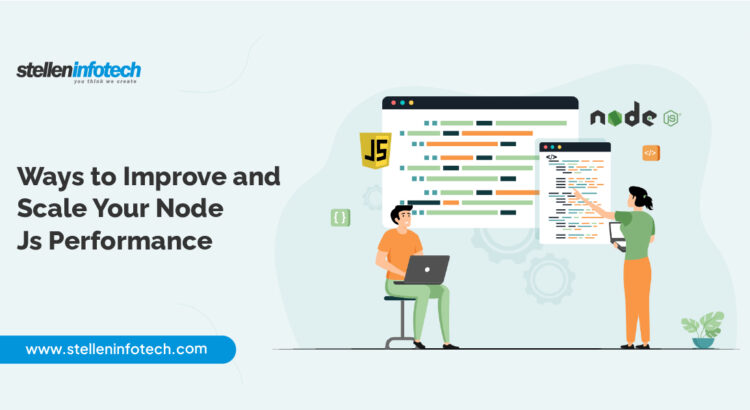Are you tech wizards or Node.js enthusiasts seeking ways to boost the performance and scalability of your Node.js applications? If yes, you have landed in the right place! Node.js has revolutionized web development by enabling developers to build fast, scalable, and efficient applications using a familiar language. It has gained immense popularity for its non-blocking, event-driven architecture, for building node js performance APIs, and web applications. However, even the most well-designed applications may face performance challenges as they scale.
In this blog, we will go deep into some invaluable tips and strategies to optimize your Node.js applications. These tips will surely be helpful in enhancing performance monitoring and achieving higher scalability. So, sit back and get ready to discover the true potential of your Node.js projects.
Most Effective Ways to Achieve Your Business Goals
As you aim to scale your Node.js applications, remember your ultimate goal: achieving business success with better performance and smooth scalability. In this section, we will unveil the most effective ways to optimize your Node.js projects and elevate your business to new heights.
- Node.js Performance Monitoring: Insights for Success
Before beginning with the optimization journey, it is crucial to gain a comprehensive understanding of your application’s performance. Implementing robust node js performance monitoring tools allows you to identify constriction, measure resource consumption, and detect potential issues in real time.
Selecting the Right Performance Monitoring Tool is crucial in optimizing the journey. Explore popular tools like New Relic, AppDynamics, and Prometheus to capture vital metrics like response times, CPU and memory usage, and database queries.
- Performance Optimization Techniques for Node.js
Enhancing the performance of your Node.js API or web application involves a combination of smart coding practices and strategic architectural decisions. Some most important strategies for node js performance optimization include:
Asynchronous Programming: Take advantage of Node.js’s event-driven nature and asynchronous capabilities to handle multiple requests concurrently. It will substantially enhance the website’s performance by reducing response time and improving scalability.
Caching Mechanisms: Implement caching strategies like Redis or in-memory caching to store frequently accessed data, minimizing the need for repeated computations and database queries.
Database Optimization: Optimize database queries, utilize indexing, and employ connection pooling to reduce latency and enhance data retrieval efficiency.
- Microservices Architecture: Scalability Redefined
Microservices architecture is a game-changing approach to achieve scalability for modern web applications. Such architecture breaks down large applications into smaller, independent services that communicate via APIs. This approach allows you to scale individual components based on demand, making your application more flexible and resilient.
While microservices architecture offers immense benefits, it also introduces challenges, such as managing communication between services, monitoring, and increased operational complexity. Therefore, proper planning, design, and use of technologies like service mesh and API gateways are essential for a successful microservices implementation.
- Load Balancing and Horizontal Scaling
Load balancing and horizontal scaling techniques ensure high availability, optimal performance, and seamless scalability of your Node.js applications. These strategies work collaboratively to distribute incoming traffic and efficiently handle increasing workloads.
- Load Balancing:
Load balancing involves distributing incoming requests across multiple servers or instances to prevent overloading a single server. This ensures that each server handles a fair share of the traffic, minimizing response time and avoiding performance obstacles. Load balancers act as intermediaries between clients and servers, intelligently directing requests to the least busy server based on predefined algorithms. It benefits in improving performance, automating traffic redirection, boosting scalability, and reducing the risk of downtime due to server failures.
- Horizontal Scaling:
Horizontal scaling involves adding more servers or instances to your application’s server pool to increase capacity. Unlike vertical scaling, horizontal scaling spreads the load across multiple servers, allowing for more efficient utilization of resources. It encourages elasticity, cost-effectiveness, easy deployment, and fault tolerance, ensuring continuous service availability.
Combining load balancing and horizontal scaling helps you create a robust and scalable infrastructure. It can adapt to changing demands, deliver exceptional performance, and provide a reliable user experience.
- Optimizing External Service Calls
Optimizing external service calls is essential for ensuring the efficient and reliable performance of your Node.js application. External services like APIs, databases, or third-party applications can directly impact your application’s overall speed and responsiveness. There are certain techniques to handle these dependencies including, caching, request batching, and circuit breaking. Implementing these optimization techniques for external service calls can enhance the resilience and performance of your Node.js application.
We are here to Help – Step up your Website Game!
Are you ready to take your Node.js applications to new heights of performance and efficiency? Look no further than Stellen Infotech, a premier IT solutions provider with a team of skilled and experienced Node.js developers. Our experts are passionate about turning your ideas into high-performing realities.
To hire Node.js developers or explore our wide range of services, visit Stellen Infotech today!
Bottom Line
Improving & scaling your Node.js application’s performance is an ongoing process that requires a combination of optimization techniques, architectural decisions, and continuous monitoring. So, roll up your sleeves, put these strategies into action, and watch as your Node.js applications touch new heights of performance & scalability. With dedication and the right approach, your applications can stand out and make a lasting impact in the dynamic world of technology!






















































